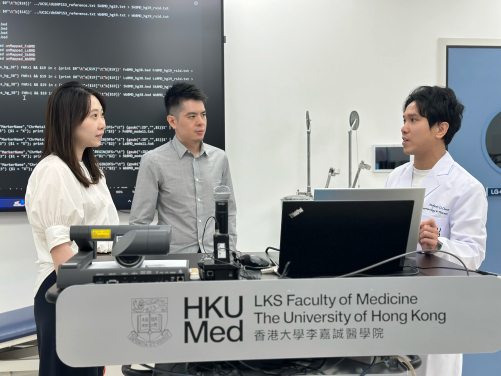Media
HKUMed study: Hip fractures may trigger cardiovascular events
Risk five times higher in patients with heart failure
09 Jan 2025

HKUMed research underscores the importance of cardiovascular event risk management in hip fracture care, particularly for patients with congestive heart failure or arrhythmia.

Led by Professor Cheung Ching-lung (left), the HKUMed research team finds that hip fracture may induce cardiovascular events, and hip fracture patients with pre-existing heart failure face a five-fold increased risk of cardiovascular events and approximately doubled mortality risk compared to relatively healthy patients.

HKUMed research underscores the importance of cardiovascular event risk management in hip fracture care, particularly for patients with congestive heart failure or arrhythmia.

Led by Professor Cheung Ching-lung (left), the HKUMed research team finds that hip fracture may induce cardiovascular events, and hip fracture patients with pre-existing heart failure face a five-fold increased risk of cardiovascular events and approximately doubled mortality risk compared to relatively healthy patients.
- 1 / 2
- 2 / 2
A research team in the Department of Pharmacology and Pharmacy, LKS Faculty of Medicine, the University of Hong Kong (HKUMed), found that hip fractures not only result in both physical and psychological injuries, but may also induce adverse cardiovascular events. In particular, hip fracture patients with pre-existing cardiac conditions are associated with a significantly higher risk of cardiovascular events (CVEs) and mortality, poorer prognosis, and greater health service utilisation. The research employed big data and artificial intelligence (AI) to uncover hidden clinical characteristics of hip fracture patients of different ethnicities, based on the electronic health records from Hong Kong and the United Kingdom (UK) of over 100,000 patients with hip fractures. The findings could enhance the current management of hip fracture patients and provide valuable insights into precision medicine in hip fracture patients. The study has been published in Nature Communications [link to the publication].
Background
The all-cause mortality rate for hip fracture patients in Hong Kong is approximately 17%, significantly higher than that for breast, thyroid and prostate cancer patients. CVEs are the leading cause of mortality among hip fracture patients, accounting for 33% of deaths. Current research has found an association between hip fractures and an increased risk of CVEs, such as heart failure and myocardial infarction. However, in hip fracture care, there is a noticeable lack of emphasis on managing patients’ CVE risk.
Hip fractures often require surgery and can result in postoperative cardiac complications. Even after accounting for these complications, there is an immediate increased risk of CVEs following hip fractures. However, considering the diverse clinical characteristics of hip fracture patients, the mechanisms underlying this temporal association are complex and remain largely unexplored.
Research findings and significance
The HKUMed research team used AI to identify distinct clusters or subphenotypes of hip fracture patients based on their clinical profiles. The team found three clusters in the Hong Kong cohort, characterised mainly by relatively healthy individuals (66%), those with metabolic-related diseases (21.4%), and those with a history of congestive heart failure or arrhythmia (12.6%).
The team found that the relatively healthy cluster exhibited a lower risk of CVEs than the other two clusters. The cluster with metabolic-related diseases had about twice the risk of major adverse cardiovascular events (MACEs) hospitalisation within 180 days of hip fracture. Conversely, the cluster with a history of congestive heart failure or arrhythmia had a significant five-fold increased risk of MACE hospitalisation in the same period. And the all-cause mortality risk and unplanned hospital visits of this cluster were twice as high as those of healthy individuals with fractures, in addition to longer hospital stays. The findings highlight the importance of CVE risk management in hip fracture care and the need to address the risk of hip fracture in patients with congestive heart failure or arrhythmia. Furthermore, this variation underscores the need to move beyond conventional management of hip fracture patients to more personalised management strategies, which may involve close monitoring, timely interventions, and the prioritisation of healthcare resources for hip fracture patients with a high CVE risk. This shift is crucial for improving the prognosis of hip fracture patients.
The team also found a significantly elevated risk of MACEs (93% increase) within 60 days after hip fracture using the self-controlled case series method. This suggests that hip fracture alone could contribute to short-term increased risk of MACE, and this risk is further heightened by the presence of pre-existing cardiac conditions and other comorbidities. The risk decreased during the subsequent post-hip fracture risk period of 61–180 days. There were similar findings in the UK cohort.
Professor Cheung Ching-lung, Associate Professor in the Department of Pharmacology and Pharmacy, HKUMed, commented, ‘Vascular calcification is a known risk factor for CVEs. Bones serve as a vital calcium repository in the body; the suddenly raised blood calcium after fractures may increase the risk of stroke and cardiovascular disease. Therefore, prompt management of CVE risk following a hip fracture is very important.’
‘Many people are unaware of the serious complications and mortality risks associated with fractures,’ added Professor Cheung. ‘Our research illustrates that hip fractures may trigger or worsen CVEs. Leveraging AI, we categorised the subphenotypes of hip fracture patients and revealed that individuals with a background of congestive heart failure or arrhythmia are at higher risk of experiencing CVEs following hip fractures. These findings can facilitate the introduction of tailored treatments for hip fracture patients, thereby mitigating the likelihood of post-fracture complications and mortality. They also pave the way for the development of more precise and fitting clinical strategies for hip fracture patients in the future.’
About the research team
The research was led by Professor Cheung Ching-lung, Associate Professor from the Department of Pharmacology and Pharmacy, HKUMed. PhD student Warrington Hsu Wenqiang and Zhang Xiaowen, from the same department, were the co-first authors. Other co-authors from HKUMed included Dr Sing Chor-wing, Professor Ian Wong Chi-kei and Dr Wallis Lau Cheuk-yin, from the Department of Pharmacology and Pharmacy; and Professor Kathryn Tan Choon-beng, from the Department of Medicine of the School of Clinical Medicine.
Media enquiries
Please contact LKS Faculty of Medicine of The University of Hong Kong by email (medmedia@hku.hk).
